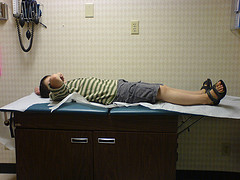Many practices and providers take their patient schedule for granted. They overlook the opportunity to improve both productivity and effectiveness by managing their schedule. Here are ten tips for office managers to make sure that the patient schedule works for you and for your practice.
1. Evaluate the schedule template with the providers and nurse manager quarterly.
By using actual issues from the previous period, discuss what has worked and what has not. Have providers share their concerns and

Image by massdistraction via Flickr
discuss their recommendations for change. Nursing often has many ideas to improve the flow of patients through the practice and is a valuable source of information. Keep track of changes made and evaluate their effectiveness at the following meeting.
2. Standardize visits types.
There are many reasons an individual provider likes their “own” schedule. As managers, we know that this makes it very difficult for the front desk staff to do their jobs. Standardization reduces the potential for errors and disruption that proprietary schedules may cause. Your role in the discussion with providers will be that of facilitator, staff advocate, and coach.
Bring forward options for standardized visit types. Many practices use a block template based on 10, 15 or 20-minute blocks of time. The number of blocks used per visit type are agreed to and used to fill the schedule. There may be additional restrictions placed on the schedule such as no more than one new patient per half-day session. Minimize the number of restrictions or ideally eliminate them to assure your days are as flexible as possible to meet your patient needs. You may also want to consider open access scheduling. Moving to this system often takes time and effort to eliminate the backlog of booked patients but once fully in place can be very successful.
3. Track scheduling errors and issues perceived to be scheduling errors monthly.
Errors in scheduling cause patient dissatisfaction, back up your waiting room, and lead to stress and possibly short tempers. Ask providers and staff to tell you when they think patients are scheduled incorrectly. Track this over time to determine if changes in the system are needed, how visit type use can be improved, and what training may be needed.
4. Know where scheduling bottlenecks are.
What is your average wait time in the office per provider? Do a time study on each provider and measure how long it actually takes for a patient to get through an office visit. Note the time they arrive for check in and registration functions, their time in the waiting room, when the nurse completes check in functions in the exam room, when the provider enters the exam room, when the provider leaves the exam room and when the patient exits the office. Overlay this on your schedule. The information you gather will help you identify bottlenecks and provide meaningful data to share with your providers when recommending a change in the schedule template.
5. Know how much a visit is worth in revenue.

Image by Libertinus via Flickr
Adding one visit per day by addressing schedule gaps, clinical start times, no-show appointments or changing the length of visits will increase your revenue. If your provider works four days per week and 48 weeks per year at an average visit reimbursement of $75, one additional visit per day will add $14,400 in annual revenue to the bottom line!
6. Train your scheduling staff and update the training regularly.
Training a new staff member often brings up questions the entire staff can benefit from. Be sure to keep track of questions and include answers in future written training materials as well as in staff meeting discussions. Develop a training checklist for scheduling staff and have both the trainer and new employee initial when each area is mastered. This checklist can also be used for annual performance reviews. For current staff, take a look at their computer terminals and see what “sticky notes” are posted there, indicating areas that need special consideration or additional training.
7. Have the schedule be a frequent agenda item for staff meetings.

Image by eyeliam via Flickr
Get the staff perspective on what is working and what is not on a regular basis. You may find that nursing can provide a great deal of information on how the schedule impacts patient flow from their perspective. Take time for staff to discuss “what if” scenarios and how they would handle a particularly difficult situation. The goal is to have a schedule that staff understands, is user friendly and is consistently used.
8. Have a policy on the number of providers out at one time for vacation or holidays and follow it.
Everyone deserves time off but having many providers out at once can lead to a very hectic week for those remaining. Plan as much in advance as possible for time away. If you do end up with a number of providers out at once, remember that the person remaining will also be responsible for reviewing lab and radiology results for their colleagues as well as answering questions regarding patients that they may not know. Allow extra time in the schedule for this.
9. Know what changes in demand to expect during the year and plan for it.
Do you have more requests for acute visits in January, camp physicals in April, or school sports physicals in August? Minimize last minute adjustments to your schedule by knowing any seasonal trends in scheduling. Take a look at the schedules from past years to predict when you need more or less acute slots and adjust your schedule template for this. Manage the time you’ve allotted by marketing efforts in the office and local papers reminding your patients to schedule in advance.
You may also want to consider adding additional clinical hours during this time to make sure you can meet demand. Consider asking part time providers for extra hours per week or using per diem staff.
10. Deal with your patient no-shows.
Consider writing a policy on no-shows if you do not have one. If you have one, follow it. Make sure that your policy follows any state regulations to avoid patient abandonment claims.
Educate your patients. Develop a set of professional communications about your visit cancellation and no-show policy that begin with your welcome to the practice letter. Post a notice of your policy in your waiting room. Send letters following each no-show and then the termination letter stating the reason for the termination and that the patient is still responsible for their account balance. Be the contact person on the letter so that if the patient calls with questions, they speak with you rather than take up provider time or that of your staff.
If you have a patient that consistently no-shows but the providers do not want to terminate them from the practice, determine what other help you can provide to get the patient to the visit on time. Consider additional reminder calls, assistance with other services such as transportation, or offering the ability to come in and wait without a scheduled time. Though this may take more staff time, the revenue from the appointment should make it worth your while.
Donna Izor, MS, FACMPE is founder of West Pinnacle Consulting, LLC. Her 20 years of experience as a medical practice executive lends her special expertise in the areas of primary care and specialty practices, employed inpatient physicians, regulatory oversight, facility design, physician compensation and relations, and new program development. She has worked with academic, community hospital, and private practices. You can contact Donna at donna.izor@gmail.com.


